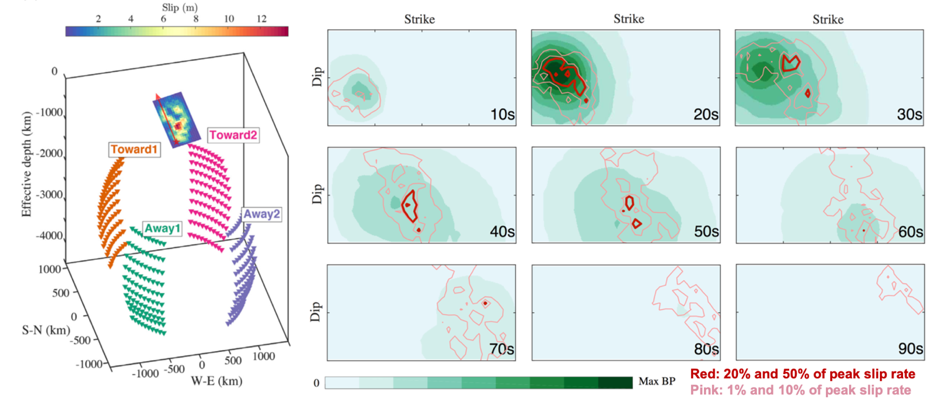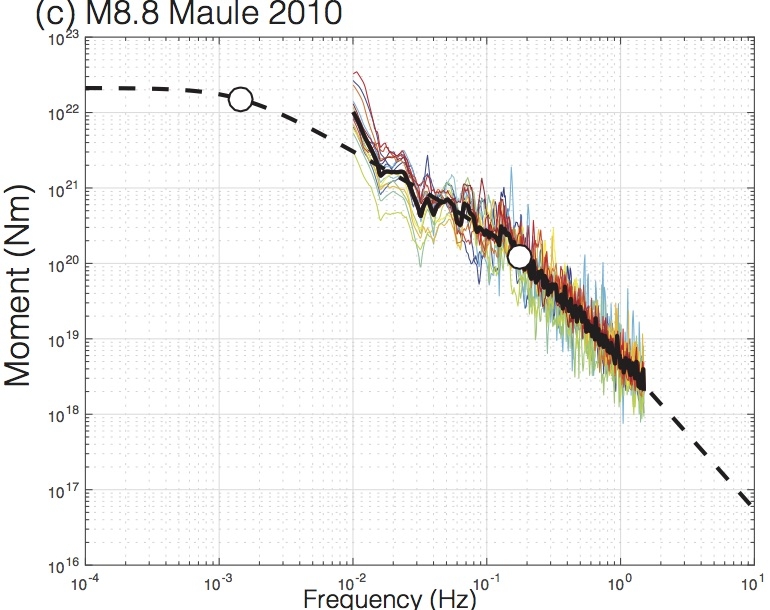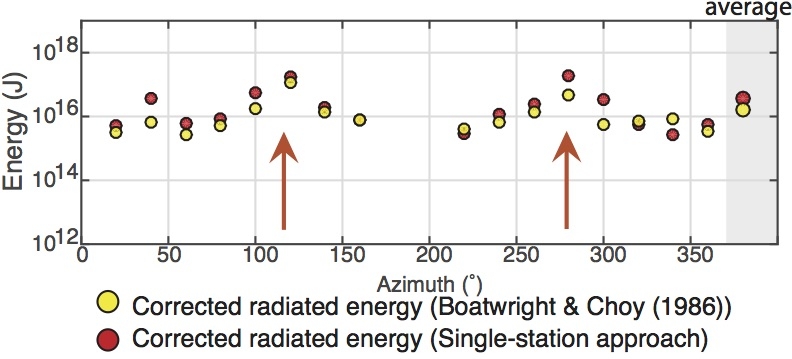We characterize the dynamics of earthquakes from both observations and simulations. We hope to validate physical models by making new observational tools to constrain the physical models of earthquake dynamics. A main endeavor in observational seismology is to accurately and correctly recover the seismic source pulse from radiated seismic waves (appropriate Green’s function), and constrain earthquake dynamics (source time function, stress drop, radiated energy). Our physical understanding and models of earthquake ought to be validated against appropriate observations. We develop new tools to validate these models. Some examples are below.
Megathrust earthquakes exhibit a ubiquitous seismic radiation style: low-frequency (LF) seismic energy is efficiently emitted from the shallowest portion of the fault, whereas high-frequency (HF) seismic energy is efficiently emitted from the deepest part of the fault. It is ubiquitous in global megathrust earthquakes between 1995 and 2021. Our work suggests that the interaction between waves and ruptures due to the Earth’s free surface is the leading mechanism that generates this behavior. Two-dimensional dynamic rupture simulations of subduction zone earthquakes support this hypothesis. Our simulations show that the interaction between the seismic waves reflected at the Earth’s free surface and the updip propagating rupture results in LF radiation at the source. In contrast, the downdip propagation of rupture is less affected by the free surface and is thus dominated by HF radiation typical of buried faults. To a second degree, the presence of a realistic Earth structure derived from P-wave velocity (VP) tomographic images and realistic VP/VS ratio estimated in boreholes further enhances the contrast in source radiation. We conclude that the Earth’s free surface is necessary to explain the observed megathrust earthquake radiation style, and the realistic structure of subduction zone is necessary to better predict earthquake ground motion and tsunami potential.

We developed different metrics to extract physical information from a large population of earthquake source time functions (mainly the SCARDEC STF database). Gaussian-subevent decomposing and DTW clustering source time functions provides us a lot of new observations. In order to investigate possible factors that control the STF complexity patterns, we perform a large number of 2-dimensional dynamic rupture simulations with stochastic distributions of pre-stress, and apply the same metrics to the resulting synthetic STFs as to the SCARDEC STFs. We have two main findings: 1) heterogeneity in the stress field on the fault interface is necressary to reproduce the large STF variability observed from our subevent-decomposition results; 2) variation of frictional parameters can obviously change the group proportions of STFs from our DTW clustering. All those results imply that there is very important dynamic information hidden in the earthquake variability, and it is very helpful for constaining rupture dynamics from the analysis on population behaviors of large samples of earthquake STFs. Please refer to our papers for more detailed discussions (Gaussian-subevent decomposition: Danré et al.,(2019); DTW clustering: Yin et al., (2021))

Comparison between the SCARDEC STFs and the synthetic STFs from 2D dynamic simulations: (Left) Number of subevent; (Right) DTW stretched STFs.
Although the backprojection (BP) methods have been successful in studying large earthquakes, the physical interpretations of the BP results are still not clear. All those previous comparisons between independent methods are qualitative. Obviously, better understandings on the BP images and their relation to the physics of earthquake rupture is significant and highly needed. In this study, we start from the theoretical formulation of the BP images, which is linear in the frequency domain, and carry on a synthetic exercise in a homogeneous fullspace. We find that the fundamental linear formulation of the BP method is most correlated with the true kinematic source properties: the images from linear BP is a snapshot of the slip motion after a spatial smoothing with a frequency-dependent resolution matrix. This direct relation between BP image and source kinematics helps to better understand and interpret the BP observations of the real earthquake rupture. Besides, the behavior of resolution matrix provides a quantitative way to evaluate the resolution of BP methods.

(modified from Yin and Denolle, 2019)
Moment-rate functions with a single time scale can be modeled with a simple spectral model with a flat asymptote at low frequency and a decay of w-2 decay at high frequencies. The dominant time scale is the source duration of the pulse. We investigate the shape of the source spectra as seen from tele seismic P waves to establish the dominant time scales in the moment rate function of moderate and large earthquakes globally recorded.

(From Denolle and Shearer (2016))
During an earthquake, the energy released partitions between fracturing of the rock, heating due to friction, and radiation of seismic waves. Kinetic energy carried by seismic waves is a dynamic measure of rupture processes. Our group research focuses on accurately measuring radiated energy and establishing its relation to static measures such as seismic moment, focal mechanism, source depth.

(from Denolle et al, 2015)
Static stress drop is the total change of shear stress on the fault from the earthquake, integrated over the fault area. Our group investigate the two approaches to estimating stress drop. First, from corner frequency measurements we can infer a source duration and from assuming a rupture velocity we can estimate a source dimension. Given simple models for uniform stress drop on a fault, we can infer the relation between stress drop, moment, and corner frequency. Second, from the inversion of teleseismic body waves to infer spatially varying slip on the fault, we estimate the stress change from the slip distribution. Our group’s research focuses on establishing the accuracy of those estimate, the validity of the assumptions, and finding the control on stress drop through correlation with source depth, mechanism, and structure.

(From Denolle and Shearer, 2016)